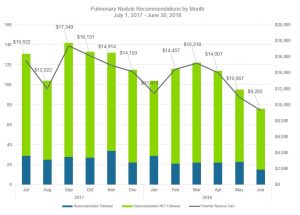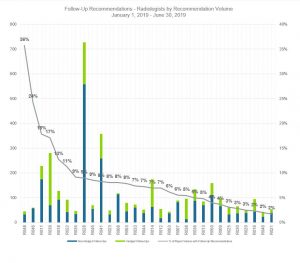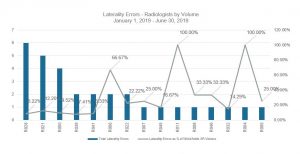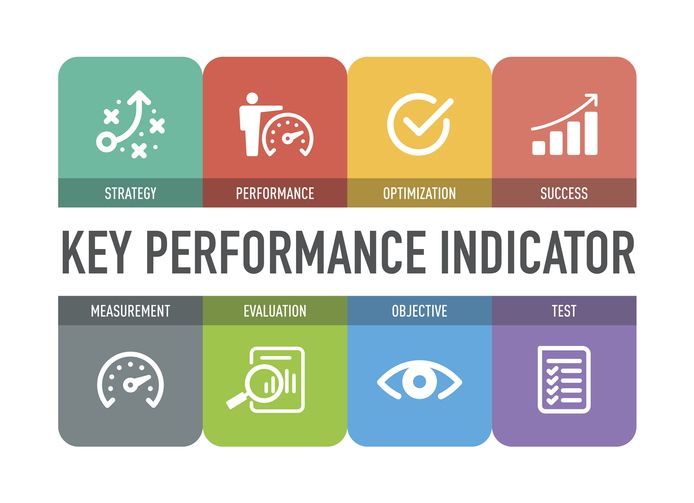Radiology quality chairs and other practice leaders know which questions to ask to evaluate performance. But getting answers to those questions from existing data has typically been a difficult and time-consuming task. HealthCheck is a service powered by Nuance’s mPower Clinical Analytics that scours unstructured data in radiology reports and generates detailed analyses to help practice leaders improve patient and financial outcomes, and address physician burnout. The service has analyzed more than 12.6 million radiology reports at 62 health systems to date. Using HealthCheck and mPower also can help prepare for PAMA compliance in 2020.
Easy access to detailed analytics is something most of us take for granted. That’s true in nearly every aspect of our business and personal lives, from sales and P&L reports, to web and social media analytics, to home banking apps, and even our workout routines and favorite sports. That’s why it’s so ironic that physicians, who capture, use, and create huge amounts of data every day, have had a difficult time obtaining actionable insights from healthcare performance and quality metrics.
Thankfully, that is changing with Nuance mPower HealthCheck, a clinical analytics service that provides a performance snapshot and informs programs for continuous clinical, quality, and financial improvement.
The HealthCheck service is run by the mPower analytics team led by Nuance CMIOs Woojin Kim, MD and William Boonn, MD. I sat down with Dr. Boonn to discuss the factors behind HealthCheck, the results from the healthcare systems that have used it to date, and how it can be used to improve clinical, quality, and financial outcomes.
KH: Nuance has been offering the HealthCheck service for a few years, and it’s having a big impact on the radiology practices that have used it. Can you bring us up to speed on that?
Dr. Boonn: Yes, Karen. It’s not an overstatement to call the impact transformational. To date, HealthCheck has analyzed unstructured data in more than 12.6 million radiology reports at 62 health systems of different types and sizes across the country. We’re seeing very positive reactions from radiology practice leaders when they realize the wealth of reports available and the ability to document specific aspects of performance.
KH: How did HealthCheck originate?
Dr. Boonn: mPower, the analysis tool that HealthCheck is built on, originally began as Dr. Kim and I were trying to answer performance, productivity, and quality questions we had as practicing radiologists and teaching professionals in Pennsylvania. We started a company, developed the mPower Clinical Analytics software, and later brought the solution to Nuance. HealthCheck uses mPower and the customer’s own data to introduce radiology practices to the power of clinical analytics with an assessment focused on five key areas.
KH: What are the key areas, and how does a customer initiate a HealthCheck evaluation?
Dr. Boonn: Five KPIs that we evaluate in HealthCheck include:
- Failed follow-up recommendations
- Compliance failures
- Laterality errors
- Sex errors
- Report variability and inconsistency
A customer simply contacts their Nuance account manager to start the process. We load a copy of the customer’s reporting data into mPower, analyze and validate it, and present key findings numerically and graphically. Radiology leaders are then able to use standard KPIs to assess their group’s performance and determine ways to respond. The data and analysis are confidential and anonymized. That means we also can provide industry benchmarks that customers can use to compare their performance to other hospitals that have conducted HealthCheck evaluations.



KH: Can you talk a bit more about why these KPIs, in particular, are so important?
Dr. Boonn: Those KPIs have the greatest impacts on clinical outcomes, financial performance, imaging usage, physician burnout, and malpractice risk.
Two or three KPIs typically stand out for each institution. For example, some looked closely at “easy wins” such as gender or laterality errors by site, shift, or radiologist. The metrics can then be used to structure continuous, personalized quality improvement programs and reduce the rework that leads to burnout. Others used the reports to determine if they could hire more radiology staff, while academic facilities wanted to leverage the data to support of research grant funding.
Others tackle failed follow-up compliance, which is a serious problem that’s been documented in at least three studies. That includes one in April 2014 that reported a 71% follow-up failure rate in patients with incidental pulmonary nodules. Another in November 2017 found that 57% of follow-up recommendations were not completed on time, and a third in March 2019 reported that up to 60% of ED patients did not receive recommended follow-up exams within one year. Our HealthCheck analyses have consistently found similar rates. A HealthCheck analysis can allow practices to identify low hanging fruit – opportunities to improve follow-up compliance rates, reducing risk and improving revenue. Once identified, Nuance has a suite of solutions including Follow-up Manager, which can address these issues directly.
Patients are falling through the cracks and cancers that could have been treated early with good outcomes are progressing to advanced stages with more expensive treatments, poorer outcomes, and higher medico-legal risks. As recently as late August, a jury in Pennsylvania awarded a couple $8.5 million in damages because doctors failed to notify the patient of incidental findings of a possible tumor following a 2015 exam related to kidney stones. An ultrasound two years later revealed multiple tumors requiring surgery to remove his bladder and prostate and undergo chemotherapy. A new law in Pennsylvania requires radiologists to notify patients of certain findings directly. Even without a legislative push, it benefits all parties to get ahead of the issue now.
HealthCheck KPIs are an effective way to begin that process. If you can quantify the problem in detail at your institution, you can take advantage of new automated tools to mitigate it. A handful have done that already including Dr. Ben Wandtke at the University of Rochester who led the 2017 study I mentioned.
KH: What’s the takeaway from customers that have used HealthCheck?
Dr. Boonn: Many started the continuous improvement process because they knew the questions that they wanted to answer but had neither the tools nor the time to perform the analysis. The insights gained have been significant and wide-ranging.
Benchmarking has been important to show how the customer compared to other practices. It contextualizes the results and enables health systems to focus their QA projects where they can have the greatest impact.
KH: What’s next for HealthCheck and for using analytics to improve patient and financial outcomes?
Dr. Boonn: We expect that more radiology practices will reach out for a HealthCheck assessment. We also expect that many will take the next step and deploy the full mPower analytics solution to drill down further.
There are many compelling reasons to do that. Clinical quality, patient outcomes, revenue generation, and physician burnout top the list. Analytics can help increase revenue through improved compliance with evidence-based recommendations for follow-up exams. HealthCheck also can provide the data needed to evaluate ROI and calculate the total cost of ownership when seeking approval from hospital management for new purchases.
Finally, HealthCheck and mPower can be very effective tools for preparing for CMS Protecting Access to Medicare Act (PAMA) compliance next year. HealthCheck and mPower can analyze referral physicians and study outcomes to help practices understand and identify outliers in exam appropriateness ordering patterns. In particular, our HealthCheck analysis includes an evaluation of ordering patterns for CTA to evaluate for pulmonary embolism, one of the Priority Clinical Areas that CMA has identified for PAMA.
KH: Where can radiology leaders obtain more info about HealthCheck and mPower?
Dr. Boonn: The best way is to contact their Nuance account manager. There is a white paper that describes the role of analytics in value-based care and how mPower and HealthCheck can help. I’d also recommend Dr. Wandtke’s blog post where he shared his results using mPower and Follow-up Manager to dramatically improve follow-up compliance.
KH: Thank you, Dr. Boonn.
Arthur C. Nielsen, the founder of the ACNielsen marketing research company and the “Nielsen ratings” for measuring TV, radio and newspaper audiences, described the value of data analytics clearly when he said, “The price of light is less than the cost of darkness.” You could say the same about the actionable insights from HealthCheck and mPower. The data they provide are essential for addressing the challenges that all health systems face in improving patient and financial outcomes and alleviating physician burnout. The benefits of using data analytics – as well as the costs of not doing so now in an increasingly data-driven industry – are too great to wait.
The Real View is a Q&A blog series with Karen Holzberger, Vice President and General Manager of Nuance Healthcare’s Diagnostic Division. The Real View cuts through the hype and gets to what’s real, here, and now. The blog series features interviews and insights from health IT movers and shakers – and uncovers disruptive technologies that solve challenges, optimize workflow, and increase efficiencies to improve patient care.






